影响纳米粒药动学、体内分布和肿瘤渗透率的因素[摘要 ] 将载药纳米粒递送至肿瘤部位主要有三个过程:避免被网状内皮系统(RES)清除和肾脏过滤,在体液中长循环;通过肿瘤部位扩大的血管内皮间隙进入致密的肿瘤基质,最终到达肿瘤细胞;维持在肿瘤部位的有效滞留时间,并释放所载药物从而发挥治疗效果。在递送的过程中,会受到多重因素的影响,RES 与纳米载体的相互作用以及纳米粒子的物理化学性质、材料、肿瘤和患者的特点均对递送效率和治疗效果发挥很大的影响。本文对纳米粒的理化性质和生物因素如何影响递送纳米粒至肿瘤部位的过程做了较为全面的阐述,并讨论了如何提高递送治疗效率以期达到最佳的治疗效果。最后,对纳米粒在肿瘤治疗中的应用前景及发展方向进行了展望。[关键词 ] 纳米递药系统肿瘤基质体内分布药物释放[ABSTRACT]There are three major phases in nanoparticle drug delivery: nanoparticles must evade clearance by renal filtration and the reticuloendothelial system;extravasate through the enlarged endothelial gaps in tumors,penetrate through dense stroma in the tumor microenvironment to reach the tumor cells;remain in the tumor tissue for a prolonged period of time, and finally release the active agent to induce pharmacological effect. Of course, nanoparticle drug delivery to the tumor is impacted by multiple factors:interact between RES and nanoparticles and the physicochemical properties of nanoparticles, composition, tumor biology and patient characteristics affect the pharmacokinetics, biodistribution, intratumoral penetration and tumor bioavailability. This review provides a comprehensive summary of how these nanoparticle and biological factors impact nanoparticle delivery to tumors, with discussion on how the tumor microenvironment can be adjusted and how patients can be stratified by imaging methods to receive the maximal benefit of nanomedicine. Perspectives and future directions are also provided. [Keywords] Nano-drug deliver system, tumor ...


